Mary Tudor and the Stratford Martyrs
By that time Henry had another wife in waiting and this time Jane Seymour produced his long awaited son, christened Edward, but she was to lose her life in doing so.
At the marriage of Henry to Jane both Mary and Elizabeth were declared illegitimate by parliament. Time passed and Henry’s reign came to an end which brought his nine year old son Edward to the throne, sadly Edward wasn’t to live to adulthood and he died in 1553 at the age of fifteen.
Now Mary saw her chance to take her rightful place on the English throne and validate her birth and her mothers marriage, but John Dudley the chief councilor to the late King Edward, and second only to the King in his power, had other ideas, he knew that should Mary, or even Elizabeth take the throne he would not only lose his special position, but would be lucky to keep his head.
Some years earlier Henry Vlll’s sister had sent her daughter Jane to court and
Dudley had become her guardian, it was in Jane that he sought to retain his power, he convinced her parents that the marriage of Jane to his son would be benifical to all, they agreed and a marriage was hastily arranged for May 25th 1553.
Somehow Dudley convinced the Council that Mary was not fit for three reasons; her mother's divorce from Henry VIII, her Catholicism and her sex, and Jane was declared Queen even though she protested saying "The crown is not my right and pleaseth me not. The Lady Mary is the rightful heir." But it was no good others thought they had more at stake, but how wrong they were for because of their lust for power young Lady Jane Grey was only Queen for nine days before Mary was announced as rightful Queen and poor Lady Jane Grey took the short walk from the tower to the execution block.
From the start of her reign Mary intended to bring England back to Catholicism, even having secret negotiations with the Pope, but at the same time she tried to compromise with the Protestant population, it was only after news of her proposed marriage to Phillip of Spain and the failed raising of a force against her by the Protestant Sir Thomas Wyatt that the burnings began.
By Christmas Parliament had passed 'An Act for the Renewing of The Three Statues made for the Punishment of Heresies', which reinstated the Act for the Burning of Heretics of 1401. Protestants up and down the country from villages and towns, labourers and craftsmen, intellectuals and men of religion were all sent to the stake. Nicholas Ridley, Bishop of London, Hugh Latimer, Bishop of Worcester, John Philpot, Archdeacon of Westminster, John Hooper, Bishop of Gloucester and John Rogers, a married priest, were all burnt at the stake by Mary's order. The former Protestant Archbishop Cranmer was burned in November of 1555 dramatically thrusting his right hand into the fire as a symbol of his dismissing the recantation he had written Queen Mary.
Of course all the burnings were scenes of inhumanity and horror such as one that happened on 27th of June 1557 in that part of east London which is now known as Stratford. On that summers day
eleven men and two women went to the stake.
They were Henry Wye a brewer, W Hallywell a smith, R Jackson a servant, L Perman a smith, J Derifall a labourer, Edmund Hurst a labourer, T Bowyer a weaver, G Seales a tailor, Lyon Cawch a merchant, H Addington a sawyer, J Routh a labourer, Elizabeth Pepper wife of T Pepper a weaver, and Agnes George wife of R George.
They had been brought from Newgate prison where they had been held, there had originally been fifteen in their number but three had recanted so they didn't face the flames.
The men were tied together like so much firewood tossed on the blaze to keep the fire burning, the two women, one of whom was pregnant was allowed to walk into the flames, it‘s said that all died bravely for their faith.
This tragic event happened on a large green space which extended from where St John’s now the Stratford martyrs memorial stands to Water Lane and the site of the university of East London which was once called Gallow’s Green.
Only a small part still exists and that is the churchyard of St John’s church where in 1879 a memorial was unveiled in their memory.
Mary Tudor died the following May, and Protestant Elizabeth came to the throne. It was during Elizabeth's reign that her half sister became known as 'Bloody Mary'.





2 Comments:
The portrait of the top is of Mary Tudor, Henry VIII's sister, not his daughter Mary. A copy of the portrait hangs in Sudley Castle. Loved your article :-) very informative thank you x
Thanks for that Rachel. Now I have the right person she looks more in keeping with her nickname.
Post a Comment
<< Home